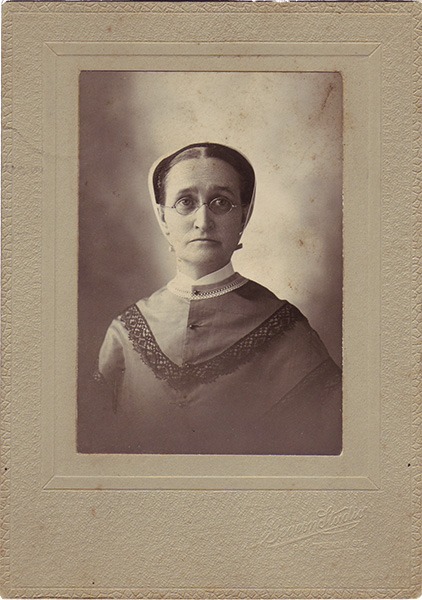
Carte de visite
Beacon Studio, Photographers, Boston, MA, ca. 1890
Private collection
Sister Mary Darling
Mary Darling, Shaker infirmary nurse, was born April 5, 1850, in Whitehall, New York, the daughter of John Darling. Her mother’s name is not known.
Mary Darling and her sister Hester Ann were indentured to the Enfield, New Hampshire Shakers when they were very young children. Enfield membership records do not name their parents, but Canterbury’s index of members identifies their father as John Darling. The girls were born in Whitehall, New York, and came to the Shakers in 1851. Mary, only fourteen months old, and Hester not yet three, were placed in the care of the Church Family. Both girls remained Shakers for life.
By the 1850s the Shaker schools were well organized and well regarded. Hester and Mary were educated in the Church Family’s one-room schoolhouse. Their teachers included Sisters Mary Maria Irish, Ellen Russell, and Clotilda Kempton. After completing her schooling Mary rotated through family housekeeping and kitchen duties with others in her class of young adult sisters.
In 1883 when she was 33 years old, Mary became a nurse’s assistant, helping to care for the sick and elderly of her community. Now her work life centered at the Infirmary and it was also her place of residence. She and Sister Elizabeth Estabrooks served under head nurses Sister Caroline Slack, then Sister Julia Briggs, and beginning in 1899 with Nurse Sister Grace Holbrook. The date of Mary’s appointment as a Nurse Sister is not recorded, but she is listed as such in a 1907 directory and in the 1910 and 1920 U. S. Censuses. Numerous photographs of “The Infirmary Sisters”–Mary Darling, Elizabeth Estabrooks, and Grace Holbrook–were taken between 1900 and 1918.
Over the years Mary had several opportunities for travel with other Enfield Shaker sisters, including attending seasonal fairs to sell fancy work with Sister Henrietta Spooner, accompanying Trustee Caroline Whitcher to Boston, visiting at Canterbury Shaker Village, and even “visiting friends in Stoneham, Massachusetts.” When Elder Abraham Perkins died at Canterbury in 1900, Mary Darling, Eldress Rosetta Cummings, Sister Edith Gould, and Elder William Wilson represented the Enfield Shaker family at his funeral.
In October 1918 the Canterbury Ministry, Elders, and Trustees met to make some hard decisions about Enfield’s future. They concluded that “Enfield has not sufficient firewood, and it is thought advisable to close all the buildings but the Office.” The sisters living in the Great Stone Dwelling could be accommodated in their Trustees Office building, but what about those living at the Infirmary? On November 7, 1918, four days before an Allied victory would be declared ending World War I, Canterbury Trustee Sister Josephine Wilson made this entry in her diary: “Irving [Greenwood] returns from Enfield with Sisters Myra Green, Elizabeth Estabrooks, Mary Darling and Flora Appleton who are coming down to live at Canterbury.” The Enfield infirmary could now be closed, and on December 23rd Sister Josephine wrote, “Irving goes to Enfield with Bateman the plumber to take from Infirmary the large hot water tank and other plumbing fixtures. These will be brought down and used in the ‘New House.’” Enfield House, as it would later be called, was being prepared for occupancy by the Shaker sisters still residing at Enfield.
Mary Darling died on October 3, 1922, at the Shaker community in Canterbury, New Hampshire at the age of 72. She is buried in the Church Family Cemetery in Canterbury. She had lived for just four years in her new home.
At the time of her death, Ann Cummings wrote “a tribute of love for our dear Sister Mary.” In it, she remembered the care and kindness of her friend of seventy years. She also seemed to be thinking of Mary’s infirmary companion, Grace Holbrook who chose to leave the Shakers and move to nearby Lebanon, New Hampshire, rather than relocate to Canterbury with her Shaker sisters. “Those who should have stood by and with her as helpers have failed on the right and left; still she has remained loyal to our home and its interests. Farewell dear sister. We will soon meet you where parting is no more.”
Original author: Mary Ann Haagen

